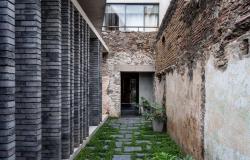
Carmen Cervera, Baroness of Thyssen, wants to open a museum with part of her artistic collection in the center of Barcelona. She has a pre-agreement with an investment fund, Stoneweg, and with the family that owns the property where the art gallery is planned to be installed, which until months ago housed the historic Comedia cinema. But the project has an economic problem that still needs to be solved. In that same property, three large stores coexist despite the fact that they are on land classified as equipment, which is why, sources in the real estate sector explain, the owners could have to give them up, and the income that their rentals offer, if they intend to obtain authorization. to renovate the building and install the new Carmen Thyssen Museum.
Technical meetings have already taken place to address the future of the project. And one of the points that emerged is the situation of the stores currently occupied by the brands Massimo Dutti (on Gran Via, in a three-story store), Guess and Oysho (the latter on the Passeig de Gràcia side) . Sources from the real estate sector assure that in Barcelona there are many precarious premises like these, occupying spaces for a use that has nothing to do with tertiary use.
The problem comes when it has to be regularized to be able to do the works. And the technicians are committed to writing a special plan. This procedure would allow for the major renovation that the entire property will need, but it would mean maintaining it as equipment and, therefore, the end of all commercial and restaurant activities that are not linked to the cultural activity of the museum (some cafeteria as a complement and a shop ). “If the special plan is not made, the cultural equipment cannot be made,” explains a person familiar with the project, who explains that there is already a space next to the Guess store that, despite having advertising for that brand, is closed. . Other sources consulted point to the possibility of overcoming the obstacle through a modification of the General Metropolitan Plan, which if the municipal technicians agreed would be a longer procedure than that of the special plan.
The owners do not want to give up the commercial uses of these three stores, which some sources consider could have a combined surface area of about 2,000 square meters. The income they receive from them is high, since Passeig de Gràcia has become the most expensive street in Spain, with average prices of about 3,000 euros per square meter, according to a report last year by the consulting firm Cushman & Wakefield.
The family owners, led by the previous president of the Círculo Ecuestre, Antonio Delgado, believe that they have the right to maintain the establishments in their current role. “The commercial premises located on Paseo de Gràcia 13, which date back to 1924, are fully legal,” he explains via email, “since they were open to the public in accordance with the regulations in force at that time. The General Metropolitan Plan, which dates back to 1976, modified land uses in Barcelona, which affects a good part of the city’s buildings, such as the premises housed in this building. Despite this change of use, the premises can maintain their activity completely normally as they were prior to the modification.”
What affects the most is what happens closest. So you don’t miss anything, subscribe.
Subscribe
Barcelona City Council sees the future museum as a complement to the expansion of the current cultural offering with the expansion of the Macba and the MNAC and avoids entering into controversy. However, a spokesperson indicates that everything will be done, “as it cannot be otherwise,” legally and that the different instruments that may eventually have to be processed will be accompanied. “The Comedia building is privately owned and it is up to it to define the future and uses of this building, and depending on what is ultimately decided, the appropriate planning will have to be processed,” say municipal sources.
The original sin lies in the fact that the property does not have a horizontal division and all the properties that comprise it are a group qualified with code 7b, which is equipment. Sources familiar with the project assure that if the building’s owner thinks in the short term, maintaining the activity of its rental stores will be more profitable, but not if it thinks in the long term. Stoneweg proposes a comprehensive renovation of the building, which would allow it to go from the current 7,000 meters of surface area to a volumetry with a surface area of nearly 10,000 square meters. But the commercial offer would be limited to what is usual in a museum: cafeteria and a store linked to its activity. The project promoters would pay rent for the space, although they would be responsible for the necessary investment in the building. At the moment, there is only a pre-agreement.
The CEO of the Thyssen Collection Group, José Daniel Barquero, trusts that the calendars of the Thyssen Museum in the old Comedia cinema will be fulfilled in “a year and a half or two years.” In a telephone conversation, the businessman and diplomat expressed satisfaction with the meeting held on Thursday between Baroness Carmen Thyssen and Mayor Jaume Collboni at Barcelona City Hall. An appointment in which the Baroness explained the art gallery project and to which they attended supported by their respective teams and members of Stoneweg’s investment team. “It was a very good and positive meeting,” he summarizes. “If something was clear to us when explaining our plan, it is that the mayor wants to do things for the city and add projects. And this is a project that suits Barcelona. The museum will generate hundreds of jobs and will attract many visits,” he added.
The Thyssen group’s plan is to exhibit in the future space around 450 Catalan works of art from the 19th, 20th and 21st centuries from the baroness’ collection. “Carmen Thyssen will exhibit the world’s most important collection of Catalan art,” she emphasized. Barquero has maintained that the reaction of the rest of the city’s large museums to the future opening of the art gallery in the heart of Passeig de Gràcia has been positive. “We have support from all the museums. We were finalists along with 15 other projects that were looking to take over that space. “We are working for Barcelona to take a step forward and further strengthen its cultural offering,” he summarized.
You can follow EL PAÍS Catalunya in Facebook and xor sign up here to receive our weekly newsletter





